Key takeaways:
- Wildlife corridors are essential for connecting fragmented habitats, allowing species to move freely and enhancing genetic diversity.
- They play a critical role in maintaining ecological balance and mitigating climate change impacts by facilitating species migration.
- Community involvement and education about wildlife corridors foster empathy and encourage proactive conservation efforts.
- Local initiatives, such as restoring green spaces and integrating wildlife crossings, show that even small actions can significantly support urban wildlife.
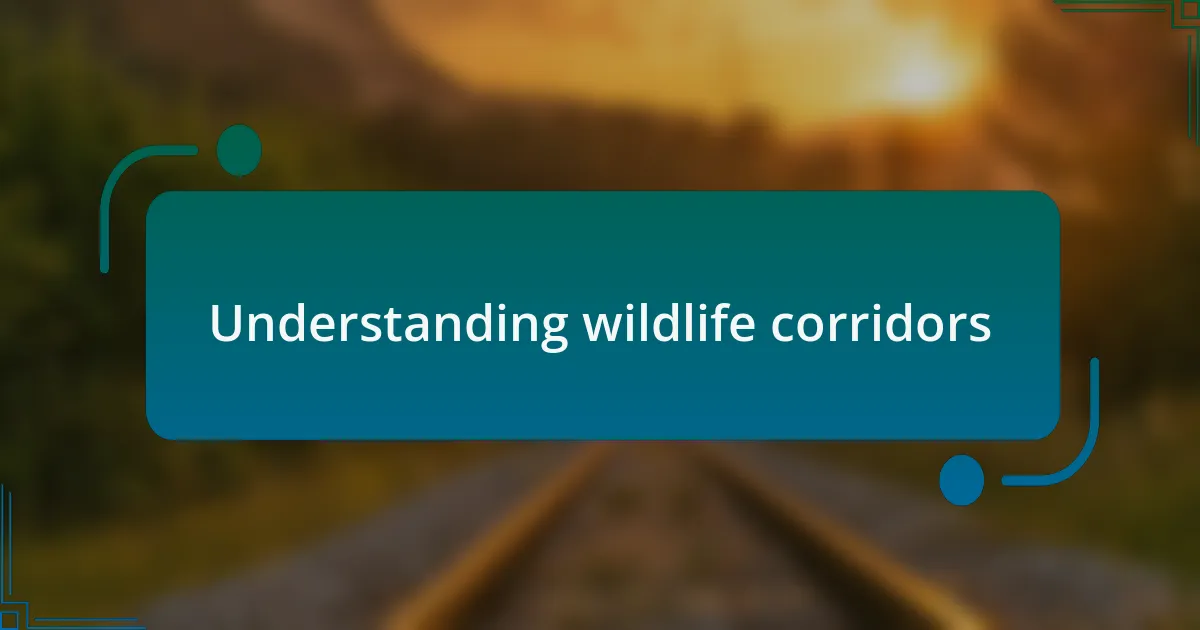
Understanding wildlife corridors
Wildlife corridors play a crucial role in connecting fragmented habitats, allowing animals to move freely between areas. I remember exploring a forest that had been divided by a busy highway. The stark contrast between the thriving wooded area on one side and the barren land on the other was shocking. It made me question, how many animals suffer because they can’t traverse these barriers?
These corridors serve not just as physical pathways, but as lifelines for species that rely on large ranges to find food and mates. Picture a family of deer trying to cross a road. The fear and stress they experience can lead to accidents and isolation. Isn’t it heartbreaking to consider how many lives could be saved simply by providing these safe passageways?
Additionally, wildlife corridors enhance genetic diversity by allowing species to mingle and reproduce with others in different areas. This diversity is vital for the resilience of ecosystems. I often wonder about the last time I saw a rare animal in the wild. If we don’t prioritize these corridors, will future generations even have the chance to experience that thrill?
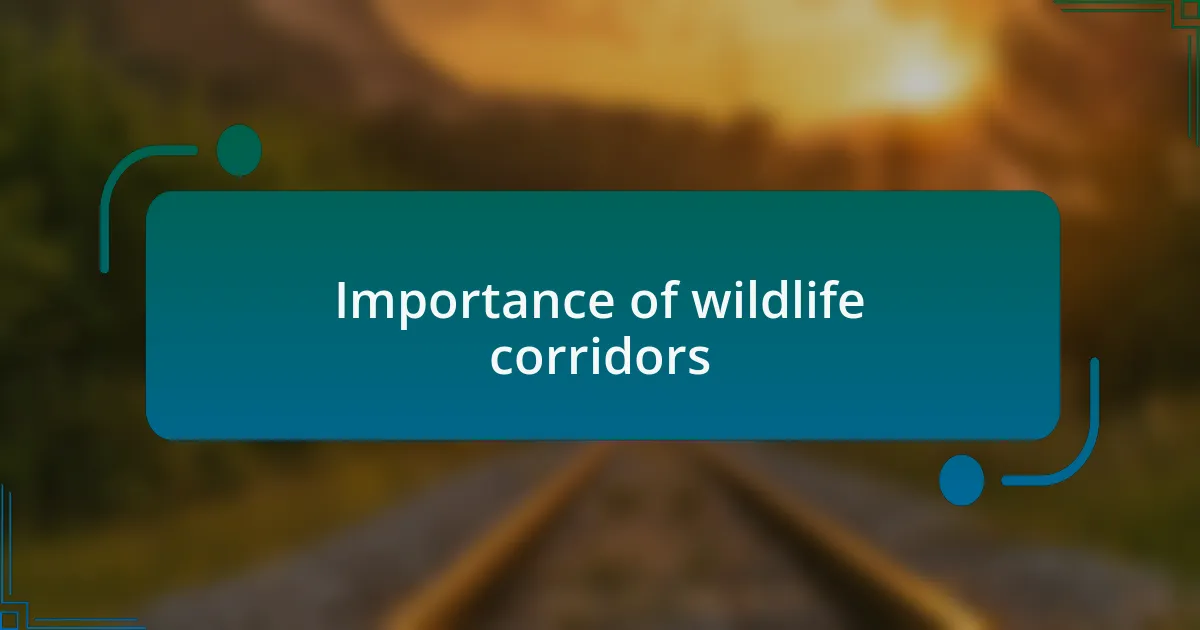
Importance of wildlife corridors
Wildlife corridors are vital in ensuring the survival of many species, acting as safe pathways that alleviate the dangers of habitat fragmentation. I vividly recall witnessing a group of foxes hesitantly navigating the edge of a busy road during a camping trip. Seeing their uncertainty made me realize just how critical it is to create spaces where they can thrive without fear of human interference.
The importance of these corridors extends beyond individual animals; they are essential for maintaining the ecological balance within an ecosystem. I often think about a river I once explored, home to a variety of fish and amphibians. As I walked along the banks, I was struck by the number of creatures that depended on an unbroken habitat to complete their life cycles. Without wildlife corridors, how can we expect these interconnected lives to flourish?
Moreover, corridors help to mitigate the impacts of climate change by facilitating species migration to more suitable habitats. I remember reading about a population of birds that increased their range in response to rising temperatures. It provoked a profound sense of urgency in me. If we don’t implement and promote these corridors now, how many more species will we lose in the future?

Benefits of wildlife corridors
Wildlife corridors offer numerous benefits, with one of the key advantages being the enhancement of genetic diversity among animal populations. I remember a documentary I watched showcasing the struggle of a small lion population isolated in a nature reserve. The lack of genetic variation led to increased vulnerability to diseases. By connecting habitats through wildlife corridors, we can help ensure gene flow, allowing species to thrive and adapt over time.
Another significant benefit lies in the improved safety of wildlife. I once witnessed a herd of deer cautiously crossing a busy highway, their lives in danger with each passing vehicle. It struck me that wildlife corridors provide these animals with safe routes, significantly reducing roadkill incidents. Is it not our responsibility to create environments where wildlife can exist without the constant threat of human infrastructure?
Finally, these corridors play a crucial role in supporting natural ecosystems, as they enable various species to access essential resources such as food, water, and breeding areas. I recall a time spent in a national park, where I marveled at the interdependence of species—from birds feeding on insects to certain plants depending on animal droppings for fertilization. Without corridors, how do we expect these intricate relationships to maintain their balance?
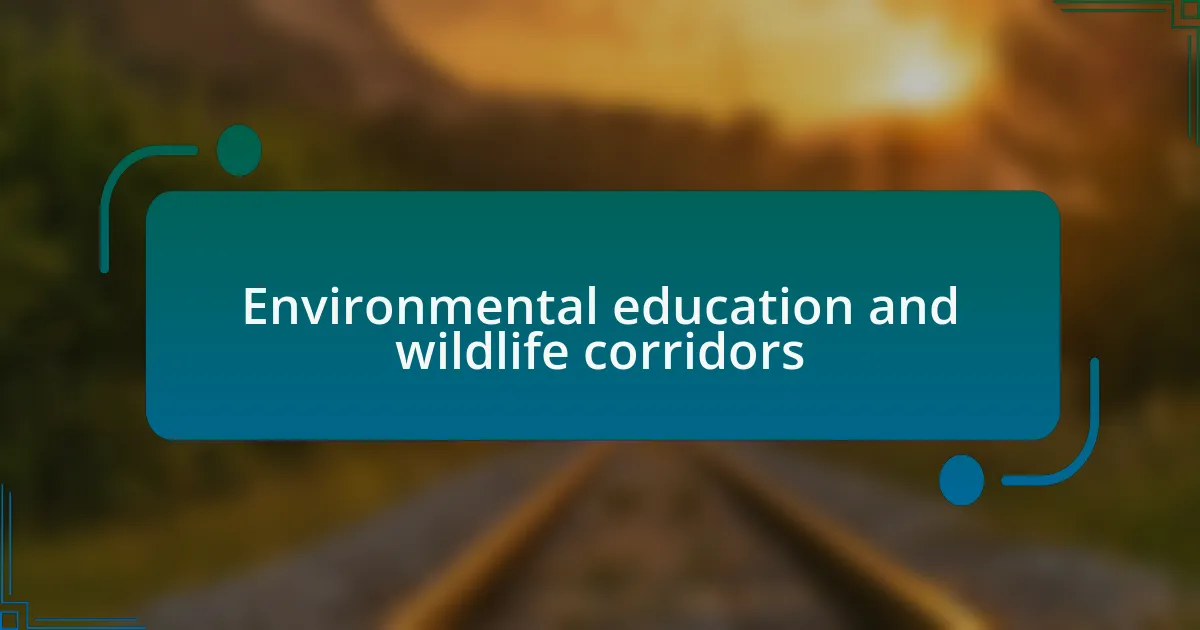
Environmental education and wildlife corridors
Environmental education plays a pivotal role in raising awareness about wildlife corridors. I often find myself reflecting on a school visit where students explored the importance of these corridors firsthand. Their excitement as they learned how corridors connect animal populations reminded me that education fosters empathy—a vital component in environmental stewardship. How can we genuinely protect our wildlife if we don’t understand their needs?
In my experience, engaging people on the topic of wildlife corridors can lead to passionate discussions about conservation strategies. I participated in a community workshop where local residents shared stories about how wildlife, like raccoons and foxes, traverse our neighborhoods using these connections. Hearing these narratives illuminated the everyday interactions between humans and nature; it made me realize that protecting these routes can be a community effort. What role can each of us play in this shared responsibility?
Moreover, effective environmental education encourages active participation in preserving these vital pathways. I remember a local initiative where families planted native plants along a corridor, fostering a sense of pride and stewardship. This hands-on involvement not only strengthens community bonds but also deepens our connection to nature. Isn’t it rewarding to think that our actions, however small, can contribute to the survival of countless species?
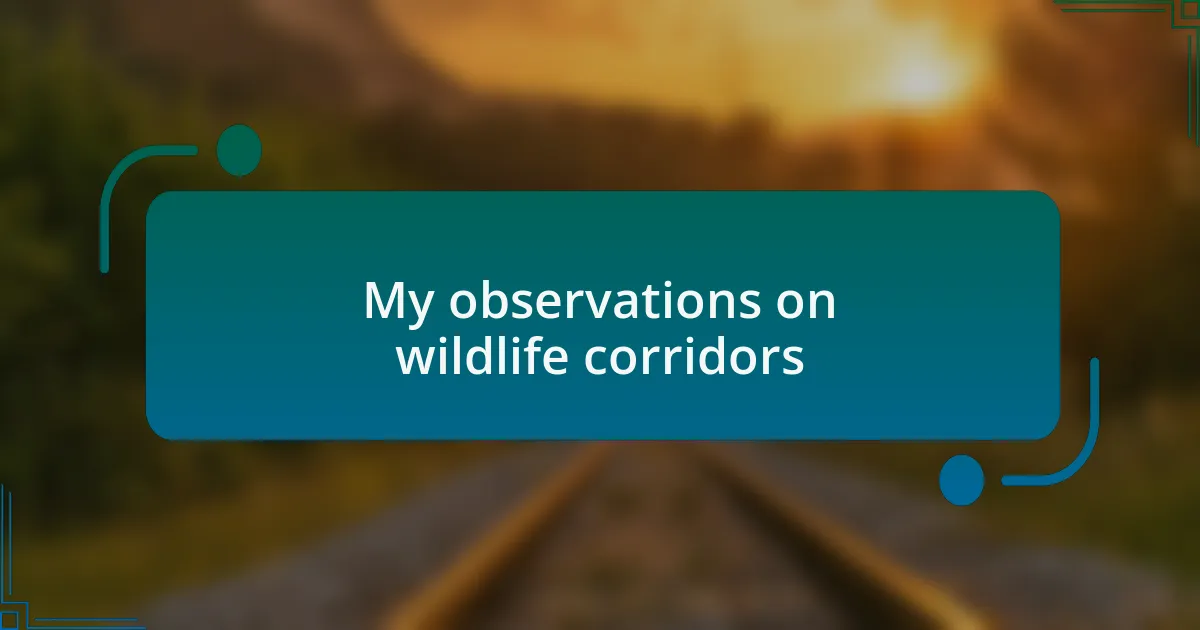
My observations on wildlife corridors
I’ve observed that wildlife corridors often serve as vital lifelines for species in fragmented habitats. One memorable outing I embarked on was a hike through a corridor that connected two forests. As I walked, I noted the diverse flora and the wildlife tracks I spotted along the trail. It struck me how these corridors not only facilitate animal movement but also enrich the ecosystem itself. Isn’t it fascinating to think about the intricate web of life that relies on these connections?
During my time volunteering with a local conservation group, I witnessed firsthand the immense difference that corridors can make. There was a project aimed at rehabilitating a corridor that had fallen into disrepair. I was taken aback by the enthusiasm of the volunteers, many of whom shared stories of how they had encountered deer, rabbits, and even the occasional bobcat thanks to these routes. It made me wonder: how many species might thrive if we prioritize preserving and enhancing these pathways?
I’ve come to realize that wildlife corridors not only support biodiversity but also foster a sense of community among people. At a recent outreach event, I spoke with a family who had turned their backyard into a mini-corridor by planting native species and removing fences. Their passion for creating a wildlife-friendly environment resonated with me, reinforcing my belief that every individual effort counts. Isn’t it empowering to think that by making small changes, we can collectively contribute to a larger movement for wildlife preservation?
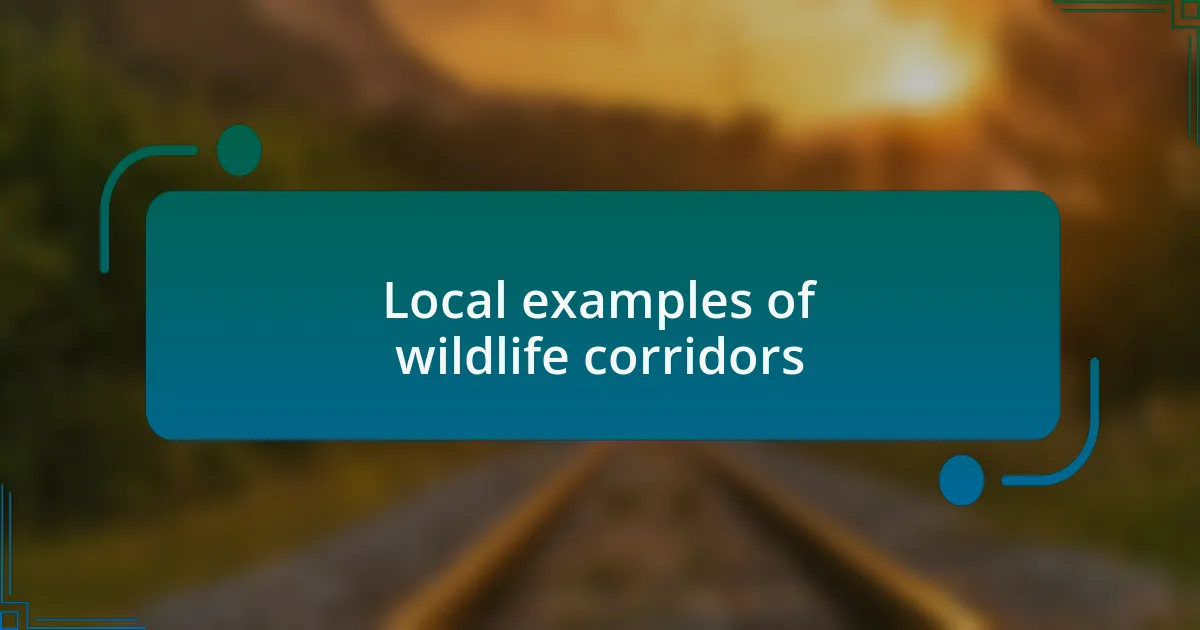
Local examples of wildlife corridors
In my own community, I’ve seen how local wildlife corridors can thrive in unexpected places. One notable example is a narrow strip of green, bordered by busy streets, that serves as a pathway for foxes and raccoons. I often find myself pausing there, watching the animals as they navigate this seemingly unsafe route. It really drives home the idea that even small, well-planned corridors can make a significant difference in connectivity for urban wildlife.
There’s a project near my home that is integrating wildlife crossings into roadways, a brilliant initiative that highlights how human infrastructure can coexist with nature. I remember visiting the site shortly after the installation of an underpass, where I witnessed a group of excited children learning about how it helps turtles cross safely. Seeing their faces light up with understanding was a reminder that educating the next generation about these corridors is crucial for their success.
Another captivating example is the network of trails connecting local parks, specifically designed to encourage species movement while enhancing community enjoyment. I often stroll these paths, reflecting on the beauty of shared spaces. It’s inspiring to think about how these corridors not only support wildlife but also bring us closer to nature. Have you ever experienced a moment in a wildlife corridor that made you feel a deeper connection to the environment? For me, these paths are a constant reminder of what we stand to gain when we prioritize wildlife movement.

How to support wildlife corridors
To support wildlife corridors, it’s essential to advocate for sustainable land-use practices in your community. I remember attending a town hall meeting where we discussed the importance of maintaining green spaces. It was enlightening to see how passionate people can influence local policy. Have you considered attending a meeting like that? Engaging with local decision-makers can be a powerful way to promote the creation and preservation of wildlife corridors.
Another impactful action is to get involved in restoration projects. I once volunteered for a weekend tree-planting event aimed at enhancing a local corridor. The satisfaction I felt while nurturing the environment was profound. It made me realize that hands-on efforts not only beautify the area but provide habitats for various species. Have you ever participated in a community project? I found that such experiences build connections with others who share a love for nature.
Lastly, educating others about the benefits of wildlife corridors is key. I often share stories from my neighborhood with friends and family, illustrating how these pathways help preserve biodiversity. Who wouldn’t want to live in a thriving ecosystem? By sparking conversations and raising awareness, we can create a ripple effect that encourages broader support for wildlife corridors.